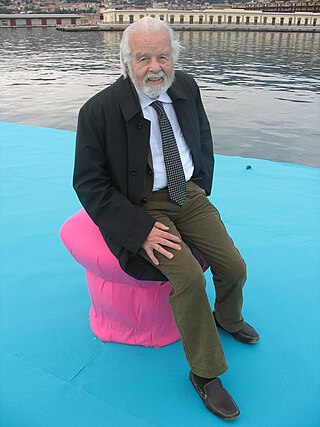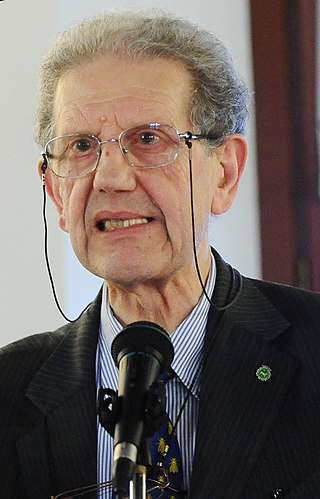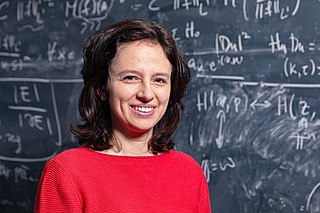Related Research Articles

The Scuola Normale Superiore in Pisa is a public university institution in Pisa and Florence, Tuscany, Italy, currently attended by about 600 undergraduate and postgraduate (PhD) students.

The International School for Advanced Studies is an international, state-supported, post-graduate-education and research institute in Trieste, Italy.
The dottorato di ricerca is the highest Italian academic degree, the equivalent of a Ph.D.
The Sant'Anna School of Advanced Studies is a special-statute, highly selective public research university located in Pisa, Italy.
The Bartolozzi Prize is awarded by the Italian Mathematical Union every two years to a young Italian mathematician. The 2019 edition was reserved to female Italian mathematicians below the age of 40. The prize is entitled in the memory of the Italian mathematician Giuseppe Bartolozzi and is worth €3,000.

Gian Biagio Conte is an Italian classicist and professor of Latin Literature at the Scuola Normale Superiore of Pisa.

Andrea Milani Comparetti was an Italian mathematician and astronomer, based at the University of Pisa.
Scuola Superiore di Catania (SSC) is an education institute in Italy. It was founded in 1998, followed by the model of Scuola Normale Superiore di Pisa. Students, who need to pass a public selection process can live for free in the school structures.

A Superior Graduate School is a completely independent institution from a legal point of view, which offers advanced training and research through university-type courses or is dedicated to teaching at graduate or post-doctoral level.
Mario Rosa was an Italian historian.

Alessandro Faedo was an Italian mathematician and politician, born in Chiampo. He is known for his work in numerical analysis, leading to the Faedo–Galerkin method: he was one of the pupils of Leonida Tonelli and, after his death, he succeeded him on the chair of mathematical analysis at the University of Pisa, becoming dean of the faculty of sciences and then rector and exerting a strong positive influence on the development of the university.

Paolo Budinich was an Italian theoretical physicist. Born in Lussingrande to a family of sailors, he grew up and studied in Trieste, where the family resided and his father Antonio Budini taught in the local high school, which Paolo attended until 1934. He later began his studies at Università Degli Studi di Pisa graduating from the Scuola Normale Superiore in 1938, with a thesis written under the direction of Leonida Tonelli.

Medea Vittoria Irma Norsa (1877–1952) was an Italian papyrologist and philologist. She headed the Istituto Papirologico Girolamo Vitelli in Florence from 1935 to 1949.

Salvatore Settis is an Italian archaeologist and art historian. From 1994 to 1999 he was director of the Getty Center for the History of Art and the Humanities in Los Angeles and from 1999 to 2010 of the Scuola Normale Superiore in Pisa.

Fabio Pacucci is an Italian theoretical astrophysicist and science educator, currently at Harvard University and at the Smithsonian Astrophysical Observatory. He is widely known for his contributions to the study of black holes, in particular the first population of black holes formed in the Universe and high redshift quasars. He discovered the only two candidate direct collapse black holes known so far, and he was in the team that discovered the farthest lensed quasar known. Pacucci is also a science educator, engaged in public talks on astronomy and science in general. Since 2018 he is a collaborator of TED in developing educational videos about science. The four videos released so far were watched by millions of people worldwide and translated into 25 languages.
Marco Santagata was an Italian academic, writer, and literary critic.

Maria Colombo is an Italian mathematician specializing in mathematical analysis. She is a professor at the EPFL in Switzerland, where she holds the chair for mathematical analysis, calculus of variations and partial differential equations.

Luigi Arialdo Radicati di Bròzolo was an Italian theoretical physicist
Andrea Ferrara is an Italian theoretical astrophysicist and science communicator.
References
- ↑ "Simona Gallerani", People, Scuola Normale Superiore di Pisa, retrieved 2023-07-28
- 1 2 3 "Per la prima volta l'Agenzia spaziale pubblica uno studio firmato da sole donne Tra i 27 e i 46 anni, hanno svelato i segreti dei buchi neri nati dopo il Big bang: Le sei ragazze italiane delle stelle "Così abbiamo conquistato la Nasa" [For the first time, the Space Agency is publishing a study by women only; between the ages of 27 and 46, they revealed the secrets of black holes born after the Big Bang: The six Italian girls of the stars "So we conquered NASA"](PDF), Le Repubblica (in Italian), 31 May 2017, retrieved 2023-07-28– via Unione Sindicale Professori e Ricercatori Universitari
- 1 2 La Quindicina del Premio Nazionale di Divulgazione Scientifica (in Italian), 2020, retrieved 2023-07-28
- ↑ Alumni of the Ph.D. in Astrophysics & Cosmology, SISSA, retrieved 2023-07-28
- ↑ Assegnato il premio Livio Gratton IX edizione (in Italian), Frascati Scienza, 2009, retrieved 2023-07-28
- ↑ Pezzulli, Edwige; Valiante, Rosa; Orofino, Maria C.; Schneider, Raffaella; Gallerani, Simona; Sbarrato, Tullia (December 2016), "Faint progenitors of luminous quasars: Why do not we see them?", Monthly Notices of the Royal Astronomical Society, 466 (2): 2131–2142, arXiv: 1612.04188 , Bibcode:2017MNRAS.466.2131P, doi: 10.1093/mnras/stw3243
